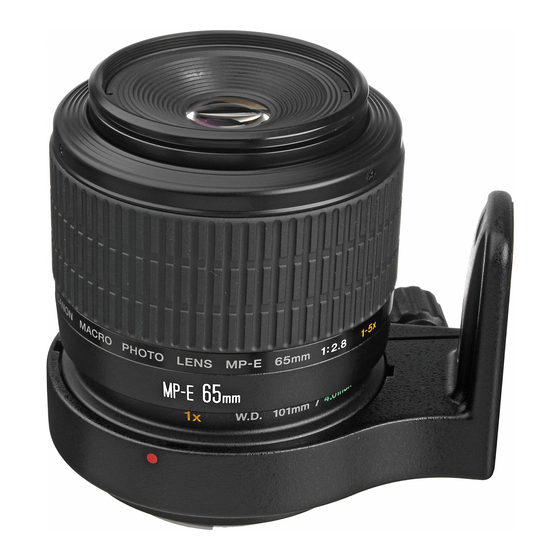Canon MP-E 65mm f/2.8 1-5x Macro Photo Instructie - Pagina 8
Blader online of download pdf Instructie voor {categorie_naam} Canon MP-E 65mm f/2.8 1-5x Macro Photo. Canon MP-E 65mm f/2.8 1-5x Macro Photo 15 pagina's. Macro photo lens

3. Setting the Exposure
Magnification and Effective f-number
The aperture displayed by the camera assumes
that the focus is set to infinity. The actual
aperture (effective f-number) becomes darker
(effective f-number increases) at closer focusing
distances (magnification increases). This does
not cause exposure problems for normal picture-
taking. However, for closeup photography, you
cannot ignore the change in the effective f-
number.
When you use a handheld exposure meter to set
the exposure, you must take into account the
exposure factor shown in the following table.
Use the following formula to calculate the
effective f-number:
Effective f-number = f-number
For example, if the aperture displayed by the
camera is f/2.8 and the magnification is 1×, the
effective f-number will be f/5.6.
Magnification
1×
Effective f/No.
5.6
× (Magnification + 1)
2×
3×
4×
5×
8.4
11.2
14.0
16.8
Setting the Exposure
The correct exposure for a close-up shot largely
depends on the subject. Therefore, try to bracket
the exposure for the same subject.
With the EOS-1Ds Mark III, 1Ds Mark II, 1Ds, 1D Mark III,
1D Mark II N, 1D Mark II, 1D, 1, 1N/DP/HS, and 1V/HS
TTL autoexposure metering is possible from 1×
to 5×. Select the desired picture-taking mode and
check the shutter speed and aperture.
With Other EOS Cameras
Since there will be a slight exposure error, using AE
metering is not recommended. Take test shots first
or use a handheld meter to determine the proper
exposure based on the effective f-number. If you use
the f-number displayed by the camera, use the
exposure factor in the table below to convert it.
Magnification
1×
Exposure Factor
+2
(stops)*
+2
*
Upper values: 1/3 stops. Lower values: 1/2 stops.
2×
3×
4×
5×
1
2
+3
+4
+4
+5
3
3
1
+3
+4
+4
+5
2
ENG-7
1
3
